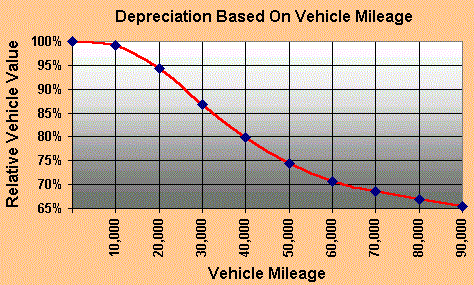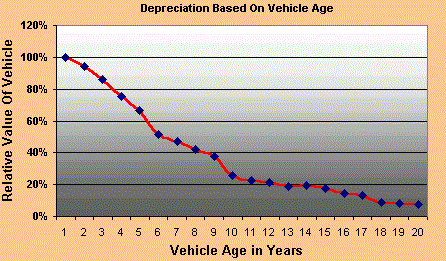|
|
|

|
| Car-Buy-Rater works by evaluating how much useful life a car has.
If you know how much useful life a vehicle has, it easy to calculate how
much that life costs and this makes it easy to choose the best vehicle. For
example, if you know a car has about 10,000 miles of useful life and costs
$10,000, the price to use the vehicle is about $1.00 per mile. On the other
hand, if you have a car that has 11,000 miles of useful life and also costs
$10,000, the cost per mile drops to $0.90. Obviously, the second vehicle
would be a better value. This is the principle on which Car-Buy-Rater works.
|
| Car-Buy-Rater uses many different factors to calculate the useful
life of a vehicle, but these break down into two basic categories. Age and
Mileage. |
| The average car lasts about 15 years. Even if it is never driven and
just sits parked at the curb, time will slowly take its toll. The sun, rain
and air pollution slowly deteriorate the paint, chrome and rubber. Even if
the car is stored in a garage, the value of any car generally depreciates
over time. Thus, one measurement of how much life is left in a vehicle is
to find out how many years are left. For example, if the car is five years
old, it will have about 10 years of life left.
|
| Most cars can be driven about 150,000 miles before major repairs have
to be made. As a vehicle is driven, mechanical parts of the car slowly wear
out. The most expensive mechanical parts of a car are the engine and
transmission. The combined average life of these two components is about
150,000 miles. Mileage also depreciates the car's monetary value, thus making
its resale value decrease with every mile you drive.
|
| Since mileage and age are two very different kinds of measurements, it
is hard to estimate the real value of a vehicle. For example, how do you
compare a 1996 car, with 20,000 miles and a price of $9,500 against a 1995
car with 26,000 miles that costs $7,500? This is one of the unique things
that Car-Buy-Rater does. It combines the age and mileage into a single
number that allows you to easily evaluate two vehicles. (It also uses many
other measurements of a car's value, but these two are the most important.)
How does Car-Buy-Rater do this? The average car is driven about 10,000
miles a year. This means that most cars have about 15 "years" worth of mileage.
This fact allows us to combine "mileage life" and "years of life" into a
single unit of measurement. In other words, a typical car has 15 year of life
and 15 mileage units of 10,000 miles each. Thus, a brand new car has 30 units
of life.
As a car ages and is driven, these units are used up. If you divide the number
of units left in a vehicle by its price, you have the cost per unit. This
makes it easy to measure the value of that vehicle.
|
| In addition to age and mileage, Car-Buy-Rater also takes into
account engine condition, body condition, transmission/drive train condition,
tire condition, consumer ratings, and the value of accessories.
Car-Buy-Rater also pays special attention to vehicle
depreciation. This is because, the rate at which a car depreciates is not
same from year to year.

This chart shows the impact of mileage on a car's value. As you can see,
a vehicle depreciates a small amount during the first 10,000 miles and then
drops rapidly during the next 50,000 miles. You will also notice that mileage
never takes the value of the vehicle below about 65%. On the other hand,
vehicle age works differently.

This chart shows the effect of age on a car's value. As you can see
the value of a car drops rapidly during the first 10 years. At the end of
10 years, the vehicle is worth only 20% of its original value and at the
end of 20 years it is worth only 10% of the original value.
As a result of these two different ways that a vehicle can depreciate,
determining the value and useful life is difficult. Car-Buy-Rater takes into
account these two measures of depreciation to help calculate the value and
useful life of a vehicle. In summary, the program uses all of this information
to calculate the cost per unit. This makes it easy to compare vehicles of
different makes, models, mileages, years and features.
 |
|
|
|